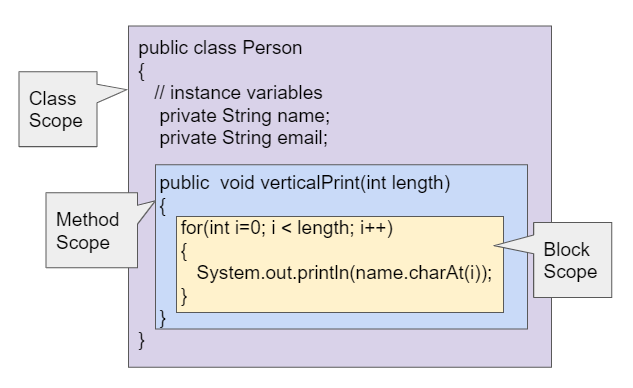Java SE: Scope
Java Fundamentals
1 Overview
In Java, the scope of a variable refers to the parts of the program where the variable is accessible. A variable has a certain scope based on where it is declared, and the scope of a variable determines where in the program the variable can be used and accessed.
There are three main types of scope in Java:
Class scope: A variable that is declared within a class, but outside of any method, has class scope, which means that it can be accessed and used by any method within the class.
Method scope: A variable that is declared within a method has method scope, which means that it can only be accessed and used within that method.
Local scope: A variable that is declared within a block of code, such as within a loop or an if statement, has local scope, which means that it can only be accessed and used within that block of code.
2 Global scope in Java?
In Java, there is no concept of global variable, and the idea of global scope differs from the traditional sense.
In other programming languages, global variables are variables that are declared outside of any function or class, and are accessible and usable by any part of the program.
In Java, however, there is no way to declare a variable outside of a class or method, so there are no global variables in the strict sense of the term.
Here is an example of class scope in Java:
Example.java
public class Example {
// Class variable
static int classVariable = 1;
public static void main(String[] args) {
// Print class variable
System.out.println(classVariable); // Output: 1
// Call method
someMethod();
}
public static void someMethod() {
// Print class variable
System.out.println(classVariable); // Output: 1
}
}Instead, in Java, the closest equivalent to global scope is class scope. In Java, a variable that is declared within a class, but outside of any method, has class scope, which means that it can be accessed and used by any method within the class.
In this example, the classVariable variable is declared within the Example class, but outside of any method, so it has class scope. This means that the classVariable variable can be accessed and used by any method within the Example class, including the main method and the someMethod method.
While Java doesn’t have a concept of global scope in the traditional sense, class scope provides a similar level of accessibility and usability for variables. By declaring variables within a class, but outside of any method, you can make those variables accessible and usable by any method within the class, which can be useful for sharing data and state between different parts of your program.
3 Key-concept: curly brackets
📘 Curly brackets are the key
In Java, the scope of a variable is determined by the position of the variable’s declaration within the code, and specifically by the presence or absence of curly braces {}.
- A variable that is declared outside of any curly braces has global or class scope, depending on where it is declared.
- A variable that is declared within a pair of curly braces has local scope, which means that it can only be accessed and used within those curly braces.
Here is an example of how scope works in Java based on the position of the variable’s declaration within curly braces:
Example.java
public class Example {
// Global or class scope
static int globalOrClassVariable = 1;
public static void main(String[] args) {
// Local scope
{
int localVariable = 2;
// Print local variable
System.out.println(localVariable); // Output: 2
}
// Print global or class variable
System.out.println(globalOrClassVariable); // Output: 1
// Print local variable (not accessible outside of curly braces)
// System.out.println(localVariable); // Error: localVariable cannot be resolved
}
}In this example, the globalOrClassVariable variable is declared outside of any curly braces, so it has global or class scope, depending on where it is declared. The localVariable variable, on the other hand, is declared within a pair of curly braces, so it has local scope and can only be accessed and used within those curly braces.
As this example illustrates, the position of a variable’s declaration within curly braces is a key factor in determining the variable’s scope in Java.
4 Conclusion
By understanding how scope works in Java, you can effectively manage the visibility and accessibility of your variables, and avoid common pitfalls such as variable shadowing and scope-related errors.
